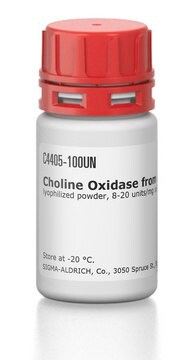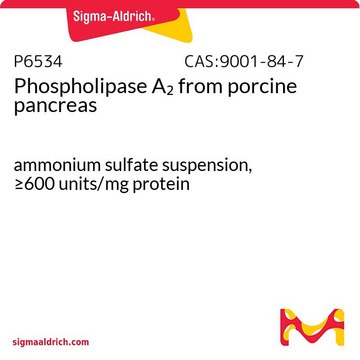P4912
Phospholipase D from Streptomyces sp.
Type VII, lyophilized powder, ≥150 units/mg solid
Synonym(e):
Lecithinase D, Phosphatidylcholine phosphatidohydrolase
Anmeldenzur Ansicht organisationsspezifischer und vertraglich vereinbarter Preise
Alle Fotos(1)
About This Item
Empfohlene Produkte
Biologische Quelle
Streptomyces sp.
Qualitätsniveau
Typ
Type VII
Form
lyophilized powder
Spezifische Aktivität
≥150 units/mg solid
Lagertemp.
−20°C
Anwendung
Phospholipase D (PLD) has been used to hydrolyze the phosphate bonds of phospholipids and sphingomyelin to yield the corresponding phosphatidic acid. It has also been used to study metabolic labeling and direct imaging of choline phospholipids in vivo by measuring propargyl-Cho incorporation. Furthermore, PLD has been used in purification and kinetic studies.
The enzyme from Sigma has been used in the translocation of sphingosine kinase 1 (SK1) to membrane fractions under in vitro conditions. It has also been used to produce phosphatidic acid (PA) from phosphatidylcholine (PC) in HL60 permeabilized cells.
Biochem./physiol. Wirkung
Phospholipase D is glycerophospholipid-specific. It is markedly less active on sphingomyelins and lysophospholipids. Phospholipase D hydrolyzes the phosphate bonds of phospholipids and sphingomyelin to give the corresponding phosphatidic acid.
Hydrolyzes the phosphate bonds of phospholipids and sphingomyelin to give the corresponding phosphatidic acid.
Verpackung
Bottomless glass bottle. Contents are inside inserted fused cone.
Einheitendefinition
One unit will liberate 1.0 μmole of choline from 1,2-Dioleoyl-sn-glycero-3-phosphocholine per hour at pH 8.0 at 37 °C.
Hinweis zur Analyse
Protein by biuret
Inhibitor
Produkt-Nr.
Beschreibung
Preisangaben
Signalwort
Danger
H-Sätze
P-Sätze
Gefahreneinstufungen
Resp. Sens. 1
Lagerklassenschlüssel
11 - Combustible Solids
WGK
WGK 3
Persönliche Schutzausrüstung
Eyeshields, Gloves, type N95 (US)
Analysenzertifikate (COA)
Suchen Sie nach Analysenzertifikate (COA), indem Sie die Lot-/Chargennummer des Produkts eingeben. Lot- und Chargennummern sind auf dem Produktetikett hinter den Wörtern ‘Lot’ oder ‘Batch’ (Lot oder Charge) zu finden.
Besitzen Sie dieses Produkt bereits?
In der Dokumentenbibliothek finden Sie die Dokumentation zu den Produkten, die Sie kürzlich erworben haben.
Kunden haben sich ebenfalls angesehen
Mohamed H Yaghmour et al.
Journal of lipid research, 62, 100022-100022 (2021-01-17)
Phospholipids with a choline head group are an abundant component of cellular membranes and are involved in many important biological functions. For studies on the cell biology and metabolism of these lipids, traceable analogues where propargylcholine replaces the choline head
Kathryn Garner et al.
The Journal of biological chemistry, 287(38), 32263-32276 (2012-07-24)
Phosphatidylinositol transfer proteins (PITPs) are versatile proteins required for signal transduction and membrane traffic. The best characterized mammalian PITPs are the Class I PITPs, PITPα (PITPNA) and PITPβ (PITPNB), which are single domain proteins with a hydrophobic cavity that binds
Christine Delon et al.
The Journal of biological chemistry, 279(43), 44763-44774 (2004-08-18)
Sphingosine kinase 1 (SK1) phosphorylates sphingosine to generate sphingosine 1-phosphate (S1P). Because both substrate and product of the enzyme are potentially important signaling molecules, the regulation of SK1 is of considerable interest. We report that SK1, which is ordinarily a
Franka Voigt et al.
RNA (New York, N.Y.), 18(12), 2128-2134 (2012-10-23)
Piwi-interacting RNAs (piRNAs) are a gonad-specific class of small RNAs that associate with the Piwi clade of Argonaute proteins and play a key role in transposon silencing in animals. Since biogenesis of piRNAs is independent of the double-stranded RNA-processing enzyme
Milya Davlieva et al.
Antimicrobial agents and chemotherapy, 57(1), 289-296 (2012-11-02)
Daptomycin (DAP) resistance in enterococci has been linked to mutations in genes that alter the cell envelope stress response (CESR) (liaFSR) and changes in enzymes that directly affect phospholipid homeostasis, and these changes may alter membrane composition, such as that
Unser Team von Wissenschaftlern verfügt über Erfahrung in allen Forschungsbereichen einschließlich Life Science, Materialwissenschaften, chemischer Synthese, Chromatographie, Analytik und vielen mehr..
Setzen Sie sich mit dem technischen Dienst in Verbindung.











